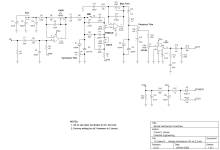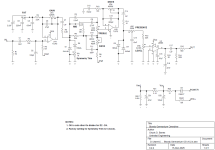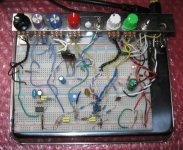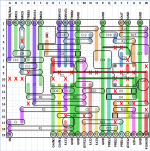Chuck D. Bones
Circuit Wizard
This is something that HamishR & II have been messing with for a few days. It's kind of an an outgrowth of the ChuckMeister. It started with HamishR taking the 1st half of the ChuckMeister (he call his version the Shredmaster) and stacking it with a circuit we call The Beast. Then we started stripping it down and eventually ended up here. His final version is slightly different for this, but definitely the same flavor of OD.
Th name came from my Random Pedal Name Generator. I had to pull the handle a few time before I got a name I liked.
Knobs (L-R): LEVEL - BASS - TREBLE - MID switch - GAIN - FAT switch
Trimmers (L-R): Presence - Symmetry - Bias

The 1st stage is right outta the ChuckMeister, except I replaced one of the 1N4148s with a 1N34A. Next comes a Fender tone stack (minus the Mid control). The MID switch selects between a mild mid scoop and a mid hump. After that we have a gain recovery stage. The Bias Trim is a misnomer, a homage to EHX*. It controls how hard the 2nd clipper (D3 & D4) is driven. I used Germanium for D3 & D4 for the softer clipping they provide. Following that is the Presence Trim, a BD-2 type tone control. For the last stage, I selected an LM386. It provides gain recovery and can drive a mile of cable. The first stage will saturate during the attack if GAIN is set high enough. The 2nd stage can saturate during the attack if GAIN and Bias Trim are dimed. The last stage can saturate if all of the knobs are dimed, otherwise it runs clean. It's Marshall-esque in that we can get mild asymmetric limiting before the tone stack and some symmetric limiting after the tone stack. It's a medium-gain pedal that can make some tube-ish distortion without trashing chords, and drive an amp pretty hard if you want that. In the middle position, The FAT switch provides treble boost, like a Marshall's Treble channel. In the up position, the FAT switch lets all of the bass thru, just like the Normal channel. The down position provides some middle ground, like if you bridged the two channels. R18 & R19 skew Vref so that U1A will saturate more-or-less symmetrically. If you sub a rail-to-rail opamp like the TLC2272, then make R18 & R19 equal.

* EHX named one of the knobs on the distortion side of the Big Muff Germanium 4 "BIAS." It doe not affect the bias in the usual way, it it controls how hard the GE clipper is driven.
Th name came from my Random Pedal Name Generator. I had to pull the handle a few time before I got a name I liked.
Knobs (L-R): LEVEL - BASS - TREBLE - MID switch - GAIN - FAT switch
Trimmers (L-R): Presence - Symmetry - Bias

The 1st stage is right outta the ChuckMeister, except I replaced one of the 1N4148s with a 1N34A. Next comes a Fender tone stack (minus the Mid control). The MID switch selects between a mild mid scoop and a mid hump. After that we have a gain recovery stage. The Bias Trim is a misnomer, a homage to EHX*. It controls how hard the 2nd clipper (D3 & D4) is driven. I used Germanium for D3 & D4 for the softer clipping they provide. Following that is the Presence Trim, a BD-2 type tone control. For the last stage, I selected an LM386. It provides gain recovery and can drive a mile of cable. The first stage will saturate during the attack if GAIN is set high enough. The 2nd stage can saturate during the attack if GAIN and Bias Trim are dimed. The last stage can saturate if all of the knobs are dimed, otherwise it runs clean. It's Marshall-esque in that we can get mild asymmetric limiting before the tone stack and some symmetric limiting after the tone stack. It's a medium-gain pedal that can make some tube-ish distortion without trashing chords, and drive an amp pretty hard if you want that. In the middle position, The FAT switch provides treble boost, like a Marshall's Treble channel. In the up position, the FAT switch lets all of the bass thru, just like the Normal channel. The down position provides some middle ground, like if you bridged the two channels. R18 & R19 skew Vref so that U1A will saturate more-or-less symmetrically. If you sub a rail-to-rail opamp like the TLC2272, then make R18 & R19 equal.

* EHX named one of the knobs on the distortion side of the Big Muff Germanium 4 "BIAS." It doe not affect the bias in the usual way, it it controls how hard the GE clipper is driven.
Last edited:






